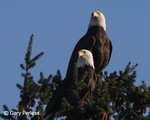Happy Solstice everyone! Summer has finally arrived, and the birds are busy.
With the Fourth of July holiday approaching, I thought it appropriate to take an appreciative look at the Bald …
This item is available in full to subscribers.
We have recently launched a new and improved website. To continue reading, you will need to either log into your subscriber account, or purchase a new subscription.
If you had an active account on our previous website, then you have an account here. Simply reset your password to regain access to your account.
If you did not have an account on our previous website, but are a current print subscriber, click here to set up your website account.
Otherwise, click here to view your options for subscribing.
* Having trouble? Call our circulation department at 360-385-2900, or email our support.
Please log in to continue |
|


Happy Solstice everyone! Summer has finally arrived, and the birds are busy.
With the Fourth of July holiday approaching, I thought it appropriate to take an appreciative look at the Bald Eagle. As this is my first installment, however, perhaps I should share a bit about myself:
I’ve always had an insatiable curiosity about the natural world, and especially a fascination with birds. I’m a passionate outdoor educator and wildlife photographer who also captures images of boats (BoatsOffPT.blogspot.com). In this monthly column, I’ll share my “field notes,” with a particular focus on the local birds of the season at hand. I welcome your questions and comments, and will try to respond in successive articles.
Why watch birds?
Bird watching has become one of the most popular pastimes in North America.
People enjoy the birds in different ways: Some feed the birds, some plant native shrubs and trees, and some take walks with binoculars or camera in hand. If you don’t know the birds’ names, a field guide can be very helpful. There are many excellent bird books, but my favorite for our area is the “Field Guide to Birds of Puget Sound” (2016, Morse Company, Olympia, Wash.) because it only covers the birds we are likely to see here, west of the Cascades. To learn more, our local Audubon chapter (admiraltyaudubon.org) offers volunteer-led bird walks and lots of educational opportunities.
I lead monthly walks at Point Hudson and Fort Flagler; great places to watch birds.
The Bald Eagle is an iconic bird, instantly recognizable by its massive size, brown body and contrasting white head and tail feathers.
A look at the eagle with binoculars brings finer features into focus: a massive yellow beak designed for tearing flesh, powerful yellow talons (claws) that can lock onto prey, and a lovely light-colored eye. With huge flight feathers along its 75-inch wingspan, an eagle can accelerate quickly as it “stoops” on a duck.
Out at North Beach I’ve watched an adult eagle bully a young eagle to drop its fish; the adult had to plop down on the water, duck-like, for half a minute while the claws got a good grip on the fish. Adult eagles weigh up to 9.5 pounds; the females are bigger than males. Another interesting fact I learned is that the young birds’ feathers are actually longer than the adults’; perhaps this helps compensate for their weaker flying muscles.
Eagles mate for life, and raise one to three chicks each year. Their nest is a massive pile of sticks, added to each year, in a treetop, always near water.
One large nest in Ohio weighed an estimated 2 tons, and lasted for 34 years, until the tree blew down.
Eagles can hunt, but they seem to prefer scavenging and stealing from other birds, especially gulls or ospreys. Smaller birds like crows often will “mob” an eagle to chase it out of their territory. Some eagles migrate, and they will move around seasonally in search of food, showing up in large numbers when salmon carcasses litter the river banks of local rivers.
Their eagle eyes are attracted to the silvery flash of a salmon skin — a friend learned this when an eagle dive-bombed her car, attracted by the foil-wrapped burrito on the dashboard!
Everyone knows that to have an “eagle eye” means powerful vision. An eagle can see about 10 times the distance that we humans see.
There are nearly 70 species of eagles found throughout the world, but the Bald Eagle is unique to North America (U.S. and Canada, and northern Mexico). Revered by indigenous cultures, the Bald Eagle was chosen as our national symbol in 1782. The bird was perceived by many settlers as a pest, and bounties were offered for dead eagles.
In the mid-20th Century, the Bald Eagle’s numbers plummeted as a result of widespread spraying of the chemical DDT against mosquitos. In 1962, biologist Rachel Carson, seeing the impact of DDT on pelicans and eagles — both fish eating birds — wrote her seminal book, “Silent Spring,” effectively blowing the whistle on the chemical industry, and launching the environmental movement.
By 1970, DDT was banned in the U.S., and thanks to legal protection under the newly-enacted Endangered Species Act of 1973, the Bald Eagle has made an amazing recovery. Here on the Olympic Peninsula, the Bald Eagle is a common yet always delightful sight.
To learn more about the Bald Eagle, go to www.fws.gov/midwest/eagle/history/index.html and www.allaboutbirds.org/guide/Bald_Eagle/lifehistory.
So while you’re celebrating our American freedoms on July 4th, consider the success story of the Bald Eagle, our iconic national symbol that was saved from the brink of extinction. Thanks to the efforts of concerned citizens and scientists who fought to protect the bird and its habitat, the Bald Eagle is able to live free and inspires us to do the same.
I look forward to your comments and questions about birds, and will try to include my responses in the next columns.
Till then, get outdoors and enjoy!
(Gary Eduardo Perless is education director with Admiralty Audubon Society. Find out how to join one of his bird walks by looking at the Events page at admiraltyaudubon.org.)